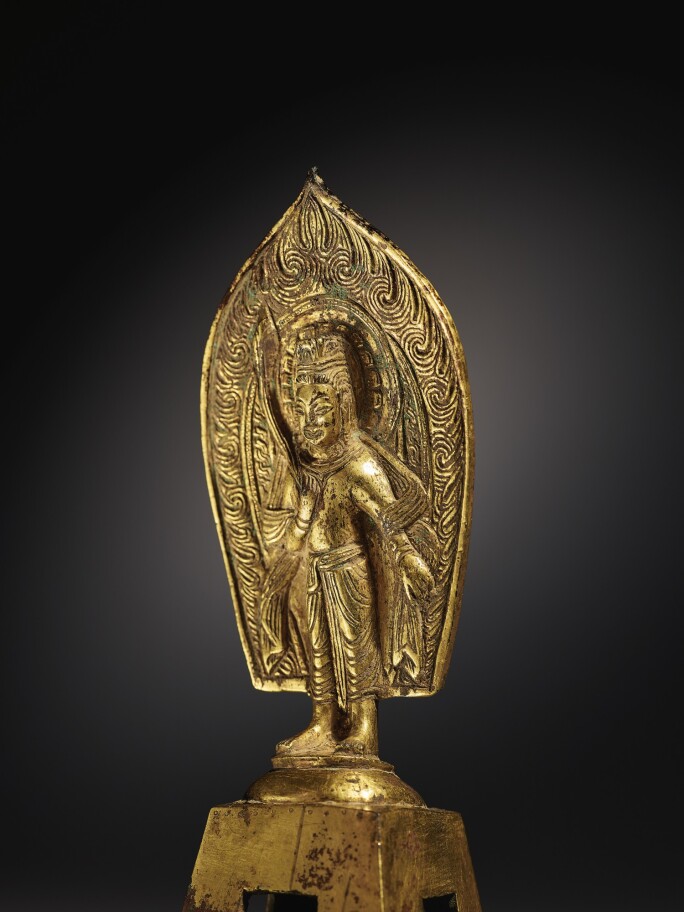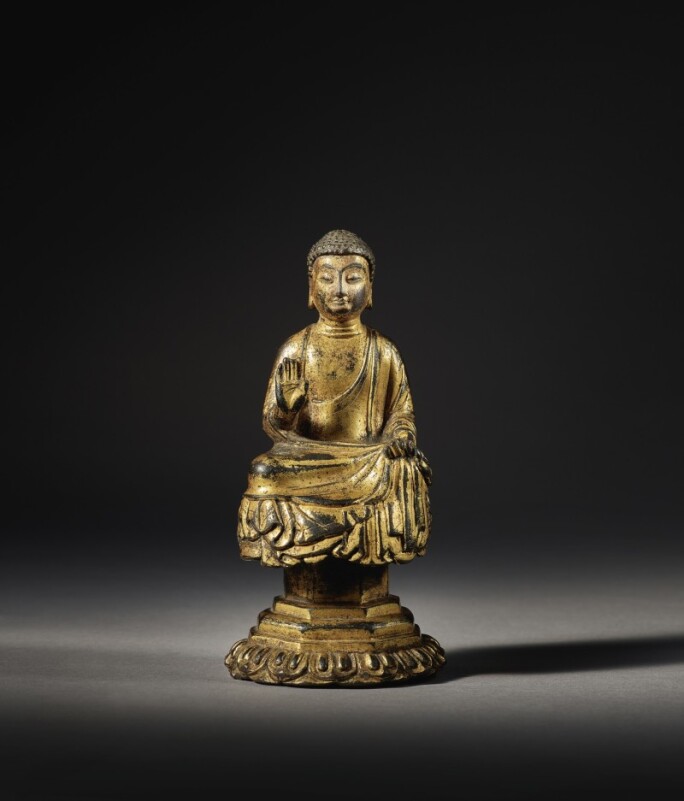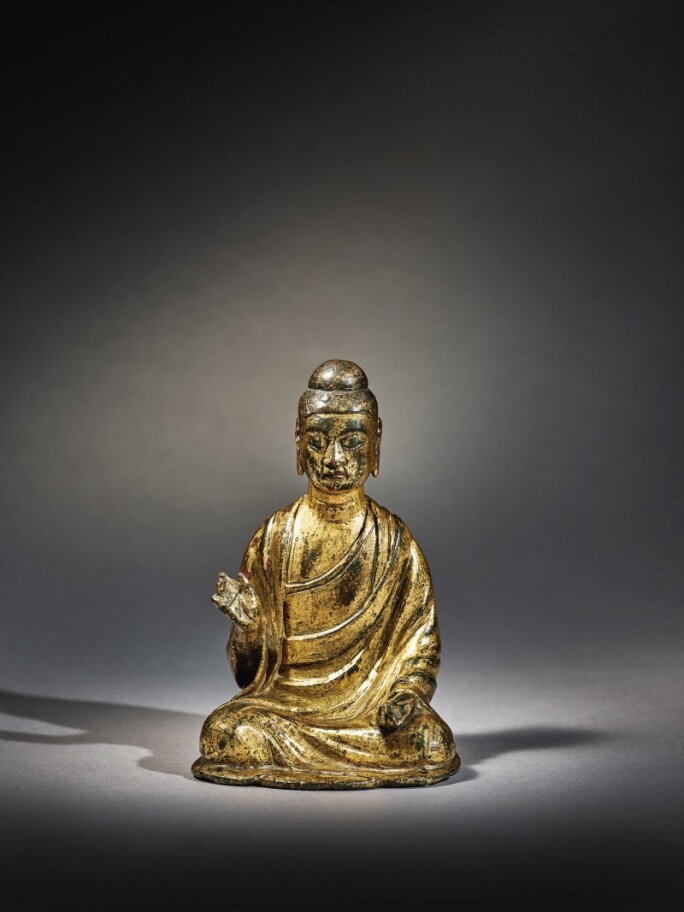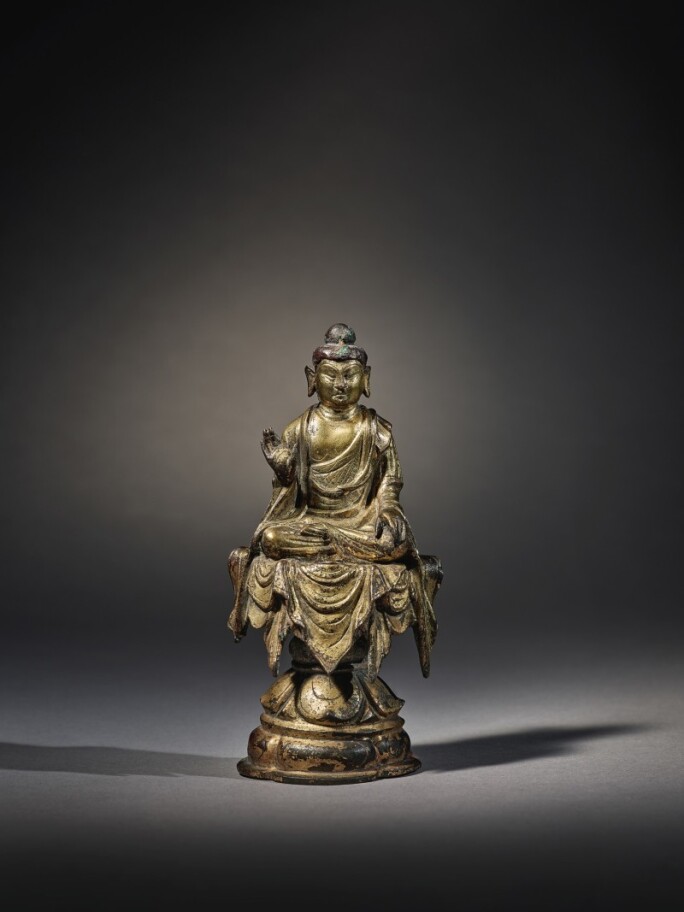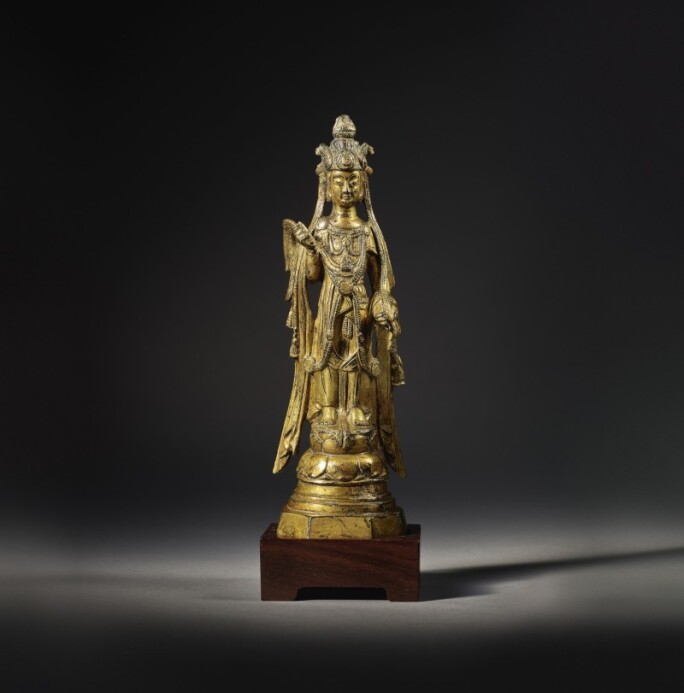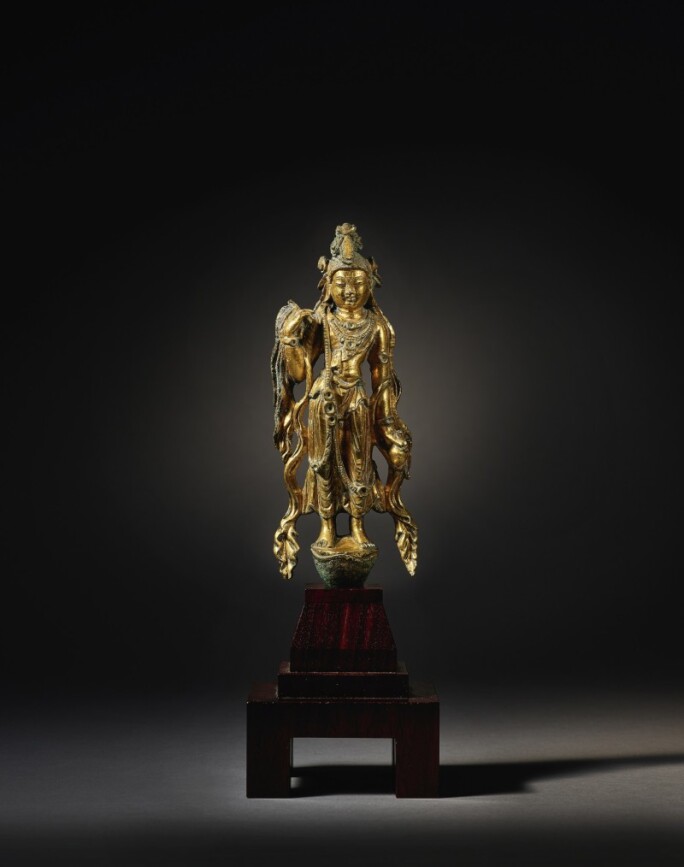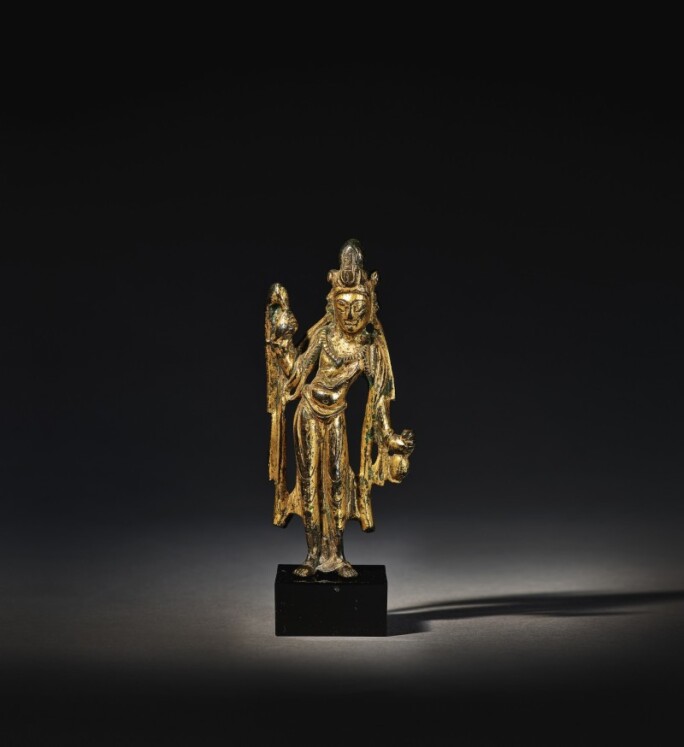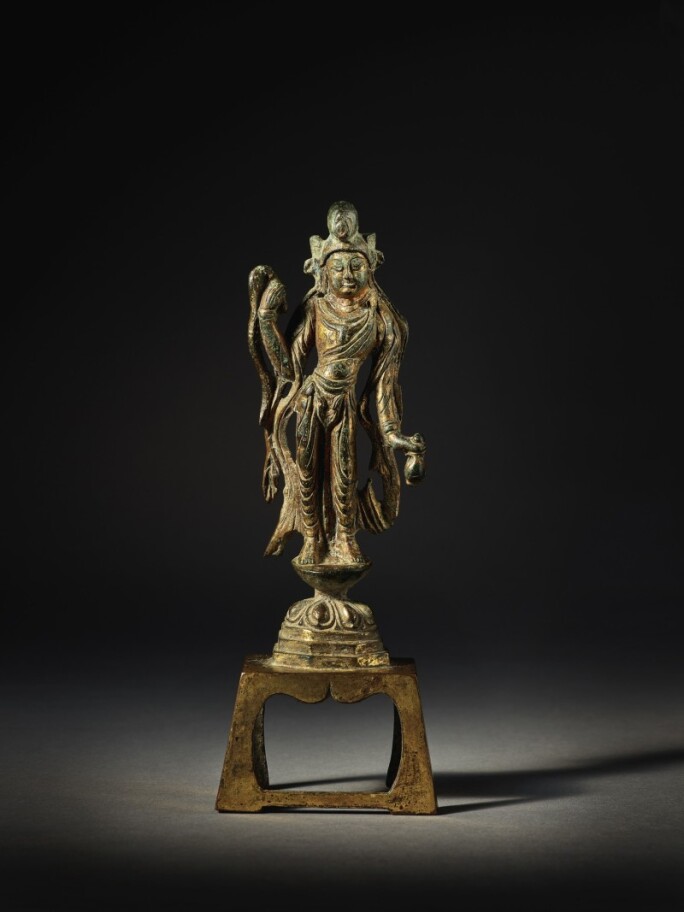Buddhist sculptures arose in India, emerging in the Gandhara and Mathura regions as early as the 1st century AD. They were transmitted to China during the Eastern Han period. During the Northern and Southern Dynasties and the Sui to Tang periods, Buddhist sculptures reached an unprecedented level of popularity in China, penetrating the aristocracy, officialdom, and all levels of the general populace and inspiring a great variety of styles. Buddhas appeared in cave temples and murals, and as freestanding stone sculptures and gilt bronze sculptures, the last type being the most unlikely to survive and thus the most precious. The 25 Buddhist sculptures in this auction were exhibited at the Museum of Fine Arts, Houston, in 2018 and published in Arts of Asia. Several of them have also been featured in numerous other publications. Below, I discuss several representative works from this museum-grade collection in further detail.
Representative Works of the Eastern and Western Wei Dynasties
In 535, the Northern Wei dynasty splintered into the Eastern (534-550) and Western Wei (535-556) dynasties, leading to the formation of two new Buddhist centres respectively in Ye and Chang’an. Because of the brevity of these dynasties, extremely few gilt bronze Buddhas produced under them have survived. Dated works from the Western Wei period are particularly rare. Indeed, only two of them are known aside from the Swergold example: one dated to the first year of the Datong reign, now at the Tianjin Museum (Saburo Matsubara, Chugoku bukkyo choukuku shi ron/History of Chinese Buddhist Sculpture, Tokyo, 1995, pl. 297c), and one dated to the fifth year of Datong, now at the Art Institute of Chicago (pl. 296). The Swergold sculptures dating to the fifth year of Datong (AD 539, lot 3503) and the second year of the Wuding reign of Eastern Wei (AD 544, lot 3515) are thus extremely precious masterpieces.
Large Bronze Figure of Shakyamuni Buddha, Western Wei Dynasty, dated to 539 (lot 3503)
Datong (AD 535-531) was the first and only era of the Western Wei, lasting some 16 years. The two subsequent Western Wei emperors had reign titles but no era titles. This Shakyamuni Buddha is depicted holding his right hand up in the fear-dispelling abhaya mudra and his left hand in the wish-granting varada mudra. He is seated in the lotus position on a symbolic Sumeru throne, which is in turn supported by a four-footed pedestal. The Buddha has a slender face with fine features, slanted shoulders, an elongated body, and long fingers. Dressed in the elegant “loose robe and wide girdle” typical of scholar officials of the Southern Dynasties, this Buddha reflects the stylistic legacy of Longmen Buddhist sculptures of the late Northern Wei period, but further emphasises local and ethnic identity in two respects. Firstly, the brows are set high above the eyes, and the eyelids are relatively level. These features are completely free from the Gandharan influence still present in the early Northern Wei dynasty. Secondly, the Buddha’s hairstyle is distinctive. The Shakyamuni Buddhas’ hair had generally been represented in a plain ushnisha, waves, or snail-shell curls. All three styles originated in Gandhara and Mathura. From the Sixteen Kingdoms period onwards, he began to be portrayed with individually articulated straight hair (see the Buddha dated to the 4th Year of the Jianwu era of the Latter Zhao dynasty, corresponding to 497), a style likely originating from local Han culture. In any case, none of these hairstyles feature horizontal lines around the base of the ushnisha, an intriguing characteristic of the present sculpture along with the straight hairline and the fine articulation of individual strands of hair. In this Buddha we see the image of an elegant scholar official of the Southern Dynasties, with a realistic hairstyle unseen in the murals and sculptures of cave temples.
The cascading hems over the pedestal, likewise originating in Gandhara art, are highly distinctive. There are obvious differences between the draperies of the Eastern and Western Wei buddhas. In the present example, the drapery has a centrifugal force and is clearly articulated into multiple layers. The robust and energetic sculptural style is typical of Western Wei Buddhas. In stark contrast to the present Buddha, compare an Eastern Wei buddha dated to 540 (Matsubara, op.cit., pl. 259b), excavated from the northwest of Jinyuan, Taiyuan, Shanxi), which is otherwise similar, but features the more naturalistic drapery and gentler lines typical of the Eastern Wei style.
Gilt-Bronze Votive Figure of Padmapani, dated to 544 (lot 3515)
When the Northern Wei dynasty fractured into the Eastern and Western Wei, most Buddhists in Luoyang migrated to the Eastern Wei capital of Ye, which quickly developed into a centre of Buddhist culture. The Padmapani form of the Bodhisattva Avalokiteshvara (Guanyin in Chinese) is his first visual manifestation and emerged after the mid-Northern Wei period (roughly 450-500), primarily in Dingzhou, Hebei, and Qingzhou, Shandong. The iconographic characteristics of Padmapani are as follows. In front of his chest he holds a lotus stalk, which extends from his shoulder upwards and contains several buds at the top. In his other hand, which hangs naturally, he grasps a portion of his scarf. Interestingly, in Indian renditions of Padmapani, he typically holds a lotus spray in his left hand, while Northern and Southern Dynasties examples may hold one in either hand.
The inscription indicates that the donor was a native of Quyang, Hebei, and indeed the sculpture can be stylistically attributed to this region. It reflects the stylistic legacy of the Northern Wei but further localises it with the physiognomic characteristics of the Northern Han Chinese. The lotus pedestal and the four-legged base are unadorned with lotus petal or floral patterns, and do not visually depict the donor. These are characteristics of Buddhist sculptures postdating the late Northern Wei period. Notably, the frontal appearance and the mandorla of the present example are strikingly similar to those of a Northern Wei Buddhist sculpture dated to 499 and now in the Palace Museum (Li Jingjie and Tian Jun, Images of Buddha, Beijing, 2007, pl. 44). However, the latter features a more elongated body, more three-dimensional facial features, and a reverse peach-shaped halo, and pictures the donor on its pedestal. The latter sculpture has been determined to be a product of Dingzhou, which like Quyang is in the modern city of Baoding, corroborating the production location of the present work.
The Shakyamuni Buddha of 539 and the Padmapani of 544 date to the early years of the Western and Eastern Wei dynasties. The Buddhist sculptures of this period, while alike localising late Northern Wei style, may differentiated by period and region. Western Wei Buddhas are consistent with the elegant image of Southern Dynasties gentleman, with slender bodies dressed in “a loose robe and a wild girdle,” his kasaya (inner robe) and scarf charged with a centripetal force that results in an overall ethereal feeling. By contrast, Eastern Wei Buddhas are consistent with the characteristics of Northern people, with full and robust bodies, muscular arms, more naturalistic dimensions, and an overall earthier character. Reflecting this stylistic polarity, the two aforementioned examples serve as reliable benchmarks for dates and geographical origins of Western and Eastern Wei gilt bronze Buddhas.
Representative works of the Sui and Tang dynasties
Seated Buddhas
During the Sui-Tang period (581-907), Buddhist sculptures reached an unprecedented height of sophistication and developed styles that perfectly reflected Chinese aesthetics. The Sui dynasty ended China’s two centuries of disunification and reopened the Silk Road, leading to a rapid renaissance of Buddhism. Buddhist sculptures of the Sui dynasty evolved from the stylistic foundation of the Northern Qi and Northern Zhou periods. During the Tang dynasty, China experienced a remarkable economic and geographical expansion and instituted liberal demographic policies. The Tang was a golden age of Buddhism, which developed into a vast and energetic system of thought and practices. The three seated figures of Shakyamuni Buddha (lot 3507) and Amitabha Buddha (lots 3508 and 3514) reflect the stylistic characteristics of three phases of the Sui-Tang period.
Seated Figure of Shakyamuni Buddha (lot 3507)
This seated Shakyamuni Buddha features a round and full face, hair in the form of snail-shell curls, a flat and low ushnisha, and a robust and muscular body. Rendered in a highly naturalistic manner, the sculpture evokes the Buddha’s humanity. Wearing a samkakshika underneath a kasaya draped over his both shoulders, this sculpture has a stronger physical presence than Northern Qi Buddhas with their draperies rendered in the stylised “water-drenched” (Caoyi chushui) manner. The present Shakyamuni Buddha raises his right hand in the abhaya mudra and holds a corner of his kasaya with his left. The folds of the robes are clearly articulated, and the hems cascade over the pedestal arranged in an orderly way. The opening of his left sleeve drapes over the pedestal in a highly decorative and rhythmic manner. Notably, the waisted Sumeru throne raised on pedestal is hexagonal—a form rarely seen in the Six Dynasties period. Such pedestals first appeared in the Northern Zhou (as in a plaque dated to the 7th year of the Tianhe era) and Northern Qi (as in an example excavated in 1954 from the Hua Pagoda in Taiyuan, Shanxi and currently at the Shanxi Provincial Museum) and became popular during the Sui-Tang period. They can be seen also in the murals and sculptures of Sui-period Dunhuang Grottos (e.g. 244, 393, 394, 419), as well as in Sui-period bronze votive plaques depicting the Buddha preaching produced in the Central Plains region (examples are at the Harvard University Art Museums and at the MOA Museum of Art in Japan). The present seated Shakyamuni is a relatively early example and likely was produced in the Central Plains region during the Sui dynasty.
Gilt-Bronze Figure of Amitabha Buddha (lot 3508)
This seated Amitabha raises his right hand in abhaya mudra and rests his left on his leg in varada mudra—one of the nine Amitabha iconographies common in the Sui and early Tang periods. As the Buddha of the Western Pure Land, Amitabha was widely worshipped by the general populace. Among extant Sui-dynasty Buddhist sculptures, Amitabhas are the most numerous and appear not only as single icons but also in ensembles representing the Pure Land (see the ensembles of five, seven, and five Amitabhas respectively at the Xi’an Museum, the Museum of Fine Arts, Boston, and the Shanghai Museum). These well-preserved and finely sculpted ensembles are the finest examples of Sui-period gilt-bronze Buddhas.
Seated upright, the present Amitabha Buddha has a prominent and unadorned ushnisha, a wide oval face, solemn facial features, downturned eyes, a long and thick neck, and slightly drooping shoulders. His robes are articulated in clean lines, and afford a glimpse of the musculature of his chest, which varies in a subtle manner evocative of human anatomy. Picturing Amitabha in a state of meditation, this sculpture is itself an absorbing work of art and showcases the maker’s superb artistry, which is equal to or perhaps even surpasses that of the three ensembles mentioned above. Compared to the Seated Shakyamuni (lot 3507) mentioned above, this Amitabha has an elongated face, a prominent ushnisha, and slender legs—closer to the typical Sui style. On the other hand, compared to the three ensembles, the body of this Amitabha is obviously strongly elongated, reflecting the style of the later Sui and early Tang period.
Seated Amitabha (lot 3514)
This seated Amitabha raises his right hand in vitarka mudra—indicating discourse and typical of Tang-dynasty Amitabhas—and rests his left on his knee. The left hand is different than that of the previous Amithabha (lot 3508). The cult of Amitabha reached a height of popularity during the Tang. In the Longmen Grottos there is a preponderance of Amitabhas produced during the reigns of Gaozong of the Tang and Empress Wu Zetian (AD 650-720). The early and mid Tang periods were the second peak of Amitabha faith after the Northern Wei period.
This Amitabha Buddha has a round face, with wave-patterned hair and a prominent ushnisha. His arched brows and upturned eyes, reflecting the physiognomy of northern nomadic peoples, are consistent with the main icon of Cave 17 at Tianlongshan created during the second phase of the site’s construction (705-712, the reigns of Zhongzong and Ruizong of the Tang dynasty). This facial rendition style appears already in Cave 2 of Tianlongshan, created during the first phase of the site’s construction (late Northern Wei to Eastern Wei periods), and can be considered part of a local tradition connected to the history of the Xianbei, the rulers of the Northern Wei dynasty, in their first capital of Pingcheng (modern-day Datong). The present Amitabha Buddha’s amply proportioned head and chest, short neck, and relatively slender limbs are also reminiscent of Tianlongshan Buddhas. He wears a samkakshika underneath a kasaya draped over his left shoulder, with loose and drooping collars. The hems cascade downwards to form ‘U’-shaped folds within a larger triangular form. On both sides of this are the cascading hems of the samkakshika, over which the ample sleeve drape. The various hems of uneven lengths create a fluid rhythm characteristic of mature Buddhist sculptures of the Tang dynasty. This Amitabha likely originated in the Central Plains during the early or mid Tang period.
Notably, a Buddha’s lotus position can take two forms: with right leg over left, known as the “Seat of Good fortune,” and the opposite known as the “Demon-Subduing Seat.” Buddhist sculptures of the Northern and Southern Dynasties period were almost exclusively depicted in the former position; the latter position emerged after the Zhenguan period of the early Tang and became popular only during the mid Tang. This chronology is consistent with the various phases of the Tianlongshan Grottos.
Among the three seated Buddhas discussed above, Shakyamuni (lot 3507) has a round and full face, snail-shell curls, a short and flat ushnisha, and a robust and ample body dressed in robes that cascade in orderly and naturalistic manner. He is seated upon a hexagonal waisted Sumeru throne. These are characteristics of the early Sui period. The first Amitabha (lot 3508) has an unadorned and prominent ushnisha, an oval face, an elongated upper torso, and slender legs. These are characteristics of the Sui and early Tang periods. The second Amitabha (lot 3514) has the features of northern nomadic peoples, with a large head, an ample chest and a strong corporeal presence, a short neck, and slender limbs. These are characteristics of the early and mid Tang periods. Comparing the three, we may observe the stylistic evolution of Buddhist sculptures during the Sui and Tang dynasties.
Avalokiteshvaras of the Willow Branch
The cult of the Bodhisattva Avalokiteshvara was transmitted to China during the 3rd century and became increasingly popular with the advent of Pure Land thought. The earliest foundational texts of the Avalokiteshvara cult are the “Universal Gateway” chapter of the Lotus Sutra, the Amitayurdhyana Sutra, and the “Entering the Dharmadhatu” chapter of the Flower Garland Sutra. Later, Tantric sutras related to the Bodhisattva were also translated into Chinese, including one known popularly in Chinese as Qing Guanyin jing or Sutra of the Invocation of Avalokiteshvara.
Avalokiteshvara of the Willow Branch was also known as the Medicine Avalokiteshvara (Yaowang Guanyin). He was venerated for his power to cure diseases, relieve suffering, and offer protection from disaster. His attributes—a willow branch held in the right hand and a vase held in the left—are drawn from the Sutra of Invocation, which describes the willow branch and pure water as instruments in a ritual to dispel evil. The ritual is thus also known as “Ritual of the Invocation of Avalokiteshvara” and “Ritual of the Willow Branch and Pure Water.” First visualised in the first half of the sixth century, this ritual had become very popular by the late Sui and early Tang periods. Afterwards, the Eleven-Faced and Thousand-Armed manifestations of Avalokiteshvara also typically featured a willow branch, a vase, or a willow branch inserted into a vase. In the Swergold Collection are four examples of Avalokiteshvara of the Willow Branch, one from the Sui (lot 3511) and three from the Tang (lots 3513, 3516 and 3518), reflecting the immense popularity of his cult during these periods.
Gilt-Bronze Figure of Avalokiteshvara (lot 3511)
This Avalokiteshvara wears a three-leaf crown with two large side leaves and a small central leaf. He has a prominent topknot. Wide tasselled ribbons hang from the crown over the shoulders. The slender face has delicate and inviting, child-like features. A scarf hangs over his chest to form a ‘U’ and drapes naturalistically over his shoulders, achieving a fine balance between formal restraint and decorative stylisation. The Bodhisattva wears a ‘W’-shaped chest ornament and a jewelled chain with a large pendant that forms an ‘X’. Elaborately adorned sculptures of Avalokite hvara such as this one had already emerged in the Northern Zhou period and became popular during the Sui and early to mid Tang periods. This figure of Avalokiteshvara is depicted wearing a skirt with two folds that conceal his waist and allow only a glimpse around his thighs of another jewelled chain. With his waist jutting slightly forward, he stands upright atop a lotus pedestal, suggesting little motion. Below the pedestal is an octagonal plinth, typical of the Sui period.
Gilt-Bronze Figure of Avalokiteshvara (lot 3516)
This figure of Avalokiteshvara is depicted with a three-leaf crown with a large central leaf and two small side leaves. He has a high topknot adorned with a small jewel. Ribbons cascade from the sides of his crown. His face is full and round, with delicate features. He has a large head and a short neck, wide shoulders and a narrow waist, and strong arms. With his hip swayed towards the right, he strikes a dynamic and alluring pose that reflects with the popular taste of the Tang dynasty. His sumptuous dress includes a double pearl chest ornament, a sash draped across his left shoulder, and a long and narrow jewelled chain worn around his right, as well as armbands and bracelets. The sash undulates delicately and elegantly as it cascades towards his legs, recalling the aesthetic of “Wu-style sashes dancing in the wind” (Wu dai dangfeng). He wears a tight and soft skirt with ‘U’-shaped folds beneath the knees. Articulated in a delicate and lively manner, this shimmering sculpture evokes an aristocratic lady of the Tang court and reflects the aesthetics and mentality of the early and mid Tang periods.
Gilt-Bronze Figure of Avalokiteshvara (lot 3518)
This figure of Avalokiteshvara is depicted wearing a three-leaf crown and has a high topknot. Ribbons cascade downwards from his wrists, and two wide ornamental sashes drape from his shoulders with no suggestion of movement. He wears a beaded chest ornament and no jewelled chain. A narrow ribbon drapes across his left shoulder. His waist is articulated with prominent musculature and sways in dramatic contrapposto. He wears a skirt with a trim along the lower waist and a hem that flares outwards. The pedestal and base are missing. Sculptures of this type generally represent attendant Bodhisattvas of Amitabha’s Pure Land. In the standard iconography, Avalokiteshvara and Mahasthamaprapta stand respectively on Amithabha’s left and right, and both on lotus thrones. While created slightly later than the previous sculpture (lot 3516) the present Avalokiteshvara was likewise typical of the early tomid Tang periods.
Large Gilt-Bronze Figure of a Bodhisattva (lot 3513)
This Avalokiteshvara wears a three-leaf crown with cascading ribbons and has a high topknot. He has a round face and clearly articulated features, including upturned eyes, a straight nose, and a small mouth. He has a large head and a narrow waist that sways dramatically towards the right in contrapposto. He wears only a chest ornament and no jewelled chains. His scarf (despite some damage) flows fluidly, infused with a luxurious feeling. He wears a sash across his left shoulder and a skirt. His elegant pose is typical of the early and mid Tang periods. An early-Tang shrine with three icons, excavated at the pagoda of Baoqing Monastery in Xi’an, also features attendant Bodhisattvas adorned with only neck ornaments and no jewelled chains (e.g. Matsubara, op.cit., pl. 660a).
Among the four Avalokiteshvaras of the Willow Branch discussed above, we have observed that the Sui example (lot 3511) wears a crown with a small central leaf and large side leaves and a large jewel on his topknot, and stands in a nearly static pose with his waist only slightly jutting forward, exuding an elegant gentility. The early and mid Tang examples show greater stylistic variety. The first (lot 3516) is sumptuously adorned a crown with a large central leaf and small side leaves, a small jewel on his high topknot, as well as necklaces, jewelled chains, armbands and bracelets. He stands in a dramatic contrapposto, his fluttering stole evoking dynamism and the allure of a court lady. The two last Avalokiteshvaras (lots 3513, 3518), while without jewelled chains, nonetheless emanate elegance and sumptuousness.
This short essay has touched upon only a few representative works among the 25 Buddhist gilt bronzes from the Jane and Leopold Swergold Collection. In its unique beauty, every work in this auction reflects the characteristics of its respective period and region. As a group, they embody the perfect fusion of sophisticated artistry and profound faith in medieval Chinese Buddhist sculpture and serve as an invaluable source for insights into the history of Chinese Buddhism.


